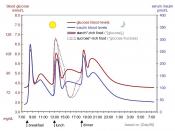Energy, in the form of sugar, is transported in the blood. It is carried throughout the body and into all cells to produce ATP. ATP is needed for all cellular activity of the body. It is essential that the blood can maintain the body's fuel at a constant level (homeostasis) regardless of how long it has been since the last meal.
There are three main organs that regulate the control of blood sugar: the pancreas, the liver and the adrenal glands. The pancreas produces hormones called insulin and glucagon. These hormones work antagonistically to maintain blood sugar levels that are neither too low or too high. The adrenal gland plays a key function in making sure blood sugar levels are high enough. The liver helps with sugar metabolism by creating insulin receptor sites.
After a meal, insulin directs the flow of nutrients. This promotes fuel storage in the liver, adipose tissue and in muscles.
The flow of nutrients during fasting is influenced by glucagon. Once glycogen stores are depleted, muscle protein is degraded, and amino acids are used for gluconeogenesis in the liver. Triglycerides stored in adipose tissue are broken down under the fasting condition.
The concentration of glucose in the blood rises rapidly after the ingestion of glucose ( in a high carbohydrate meal). Insulin carries out its function and starts to bring blood glucose concentrations back down to normal, then this removes the stimulus that tells the beta cells to secrete the insulin in the first place. As a result, the beta cells become less and less stimulated and so the rate of secretion of insulin declines in parallel to the rate of decline in blood glucose concentration. This mechanism is referred to as negative feedback.


